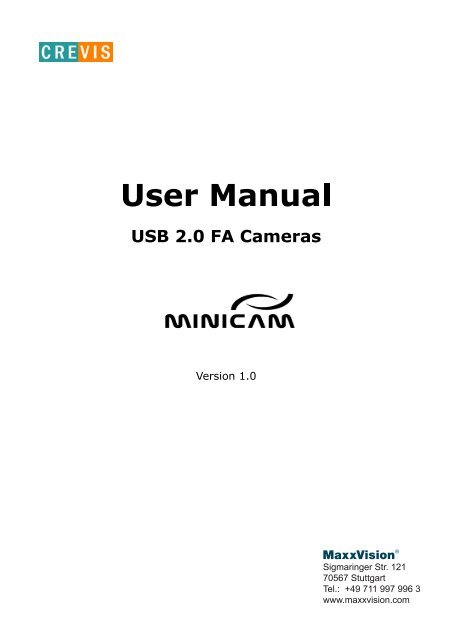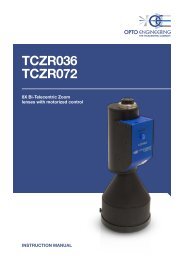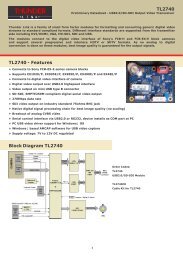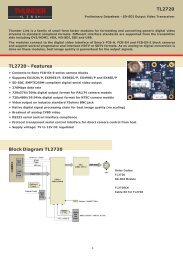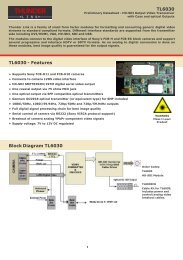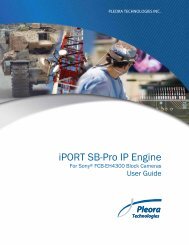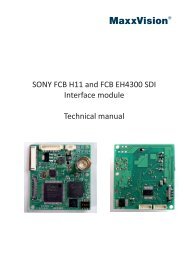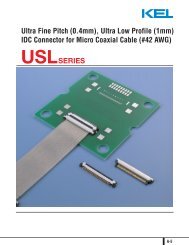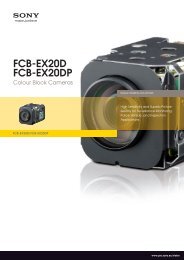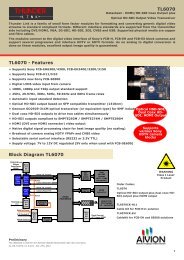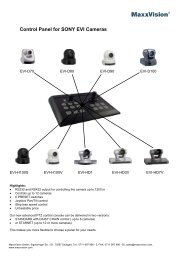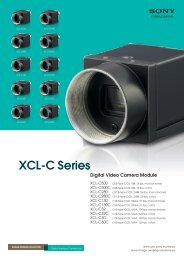Crevis CO., Ltd. - MaxxVision
Crevis CO., Ltd. - MaxxVision
Crevis CO., Ltd. - MaxxVision
You also want an ePaper? Increase the reach of your titles
YUMPU automatically turns print PDFs into web optimized ePapers that Google loves.
Sigmaringer Str. 121<br />
70567 Stuttgart<br />
Tel.: +49 711 997 996 3<br />
www.maxxvision.com
User Manual<br />
USB2.0 FA Camera Series<br />
REVISION HISTORY<br />
Rev 0.8 Page : 2/35<br />
www.crevis.co.kr
User Manual<br />
USB2.0 FA Camera Series<br />
www.crevis.co.kr<br />
Rev. Model Data Description Page<br />
0.1<br />
0.2<br />
0.3<br />
0.4<br />
0.5<br />
0.6<br />
0.7<br />
0.8<br />
0.9<br />
1.0<br />
1.1<br />
ALL<br />
ALL<br />
ALL<br />
ALL<br />
ALL<br />
ALL<br />
ALL<br />
ALL<br />
ALL<br />
Color<br />
Board type<br />
2008-09-17<br />
2008-10-09<br />
2008-10-23<br />
2009-06-30<br />
2009-07-16<br />
2009-08-27<br />
2009-08-31<br />
2009-11-16<br />
2010-02-09<br />
2010-08-17<br />
2011-02-11<br />
Established<br />
revised Table<br />
added 1.4 Mechanical drawings of Overlap<br />
function<br />
revised Demo Program<br />
added Troubleshooting<br />
added specification of color and board models<br />
changed pictures of control panel.<br />
added functions of board models.<br />
Revised 22dB into 24dB.<br />
Added notices<br />
Modified specifications<br />
Added PC Spec.<br />
Added the functions of sharpness<br />
Added the function of BinningHorizontal<br />
Added the function of InterpolationModel<br />
added Troubleshooting<br />
changed pictures of board type camera.<br />
The features and specifications, and other information provided in this preliminary data sheet, are subject to<br />
change without notice. <strong>Crevis</strong> co., <strong>Ltd</strong>. Reserves the right to make design changes without prior warning.<br />
Rev 0.8 Page : 3/35<br />
6<br />
8<br />
11<br />
9<br />
26<br />
6~9<br />
17~23<br />
22, 32<br />
20<br />
6<br />
6~9<br />
26<br />
18<br />
20<br />
34<br />
12
User Manual<br />
USB2.0 FA Camera Series<br />
Contents<br />
www.crevis.co.kr<br />
1. General.....................................................................................................................................................4<br />
1.1 Components......................................................................................................................................4<br />
1.2 System Requirements......................................................................................................................5<br />
1.3 Specifications...................................................................................................................................6<br />
1.4 Dimension (mm).............................................................................................................................11<br />
2 . Demo Program.......................................................................................................................................13<br />
2.1 McamU Demo................................................................................................................................13<br />
2.1.1 Start.....................................................................................................................................14<br />
2.1.2 Demo menus........................................................................................................................15<br />
2.1.3 Status bar.............................................................................................................................16<br />
2.2 Control Panel.................................................................................................................................17<br />
2.2.1 Camera Info ........................................................................................................................17<br />
2.2.2 Image Info ...........................................................................................................................18<br />
2.2.3 Trigger Ctrls........................................................................................................................19<br />
2.2.4 Analog Ctrls.........................................................................................................................20<br />
2.2.5 Strobe Ctrls.........................................................................................................................21<br />
2.2.6 I/O Ctrls...............................................................................................................................22<br />
2.2.7 Gamma Ctrls........................................................................................................................23<br />
2.2.8 User Set...............................................................................................................................24<br />
2.3 Processing......................................................................................................................................25<br />
2.3.1 Sharpening ..........................................................................................................................25<br />
3. Functions.................................................................................................................................................26<br />
3.1 Normal mode .................................................................................................................................26<br />
3.2 Trigger mode.................................................................................................................................26<br />
3.2.1 Trigger rising edge.............................................................................................................28<br />
3.2.2 Trigger falling edge............................................................................................................28<br />
3.2.3 Trigger Level High..............................................................................................................29<br />
3.2.4 Trigger Level Low..............................................................................................................29<br />
3.2.5 Overlap mode.......................................................................................................................30<br />
3.3 Strobe mode...................................................................................................................................31<br />
3.3 GPIO Function................................................................................................................................33<br />
4. Troubleshooting......................................................................................................................................34<br />
Rev 0.8 Page : 4/35
1. General<br />
1.1 Components<br />
Fig 1: Install CD<br />
Fig 3: USB Cable<br />
Fig 4: DC-iris cable<br />
No. Accessory Quantity Reference<br />
① Instruction Manual 1EA<br />
② Install CD 1EA<br />
Fig 2: Instruction Manual<br />
③ USB dedicated Cable 1EA Option<br />
④ Auto DC-Iris Cable 1EA Option(Only board type)<br />
Rev 0.8 Page : 5/35
1.2 System Requirements<br />
PC with at least one USB2.0-interface<br />
PC with CPU Clock<br />
Monochrome Models : at least 1.6GHz<br />
Color Models : at least 3.0GHz<br />
OS : Win2000, WinXP, Win Vista 32-Bit<br />
The USB 2.0 Port must support a 500mA.<br />
USB2.0 certified cables should be used.<br />
☞ Notice<br />
- USB 2.0 PCMCIA Card may not work with USB 2.0<br />
- This camera do not support USB1.1<br />
1.3 Specifications<br />
The model name is given according to below table.<br />
Rev 0.8 Page : 6/35
1) Products specifications<br />
- Monochrome Models(Box Type)<br />
Item MV-BS20U MV-BX30U MV-BV30U / BV20U<br />
Resolutions 1280 X 1024 1024 X 768 640 X 480<br />
Pixel size 4.65㎛ X 4.65㎛ 4.65㎛ X 4.65㎛ 7.4㎛ x7.4㎛ / 9.9㎛ x9.9㎛<br />
Optical senor class 1/2” 1/3” 1/3” / 1/2”<br />
Pixel Clock 28.6363MHz<br />
Frame Rates 15fps 30fps 70fps<br />
Binning X2<br />
HRS 1/2, 1/4, 1/6 1/2, 1/3, 1/4 1/2, 1/3, 1/4<br />
Exposure Trigger Random Trigger Pulse width/Fixed Shutter<br />
Trigger Level Low Level : 0 ~2V, High Level: 5 ~ 24V (Isolation Voltage 50V)<br />
Gain 0dB ~ 24dB<br />
Shutter<br />
125us ~<br />
66.9ms<br />
88.9us ~ 35.2ms 54.6us ~ 14.3ms<br />
Gamma Off(1), 0.45, 0.7, Table(Adjustable)<br />
SNR 58dB 58dB 60dB<br />
Min, Illumination 1.0lx(F1.4) 2.0lx(F1.4) 1.0lx(F1.4)<br />
Video Output Mono 8bit, 10bit<br />
Optical Axis Accuracy Pixel Center ±0.1mm<br />
Vibration(20~200Hz)<br />
Sweep interval : 300sec<br />
Test Time: 10min(XYZ Dir)<br />
10G<br />
Power USB Bus power(DC5V) ,
- Color Models(Box Type)<br />
Item MV-CS20U MV-CX30U MV-CV30U<br />
Resolutions 1280 X 1024 1024 X 768 640 X 480<br />
Pixel size 4.65㎛ X 4.65㎛ 4.65㎛ X 4.65㎛ 7.4㎛ x7.4㎛<br />
Optical senor class 1/2” 1/3” 1/3”<br />
Pixel Clock 28.6363MHz<br />
Frame Rates 15fps 30fps 70fps<br />
Binning Not supported<br />
HRS 1/2, 1/4, 1/6 1/2, 1/3, 1/4 1/2, 1/3, 1/4<br />
Exposure Trigger Random Trigger Pulse width/Fixed Shutter<br />
Trigger Level Low Level : 0 ~2V, High Level: 5 ~ 24V (Isolation Voltage 50V)<br />
Gain 0dB ~ 24dB<br />
Shutter 125us ~ 66.9ms 88.9us ~ 35.2ms 54.6us ~ 14.3ms<br />
Gamma Off(1), 0.45, 0.7, Table(Adjustable)<br />
SNR 58dB 58dB 60dB<br />
Min, Illumination 2.0lx(F1.4) 3.0lx(F1.4) 2.0lx(F1.4)<br />
Video Output Mono8, BayerBG8, RGB8Packed<br />
Optical Axis Accuracy Pixel Center ±0.1mm<br />
Vibration(20~200Hz)<br />
Sweep interval : 300sec<br />
Test Time: 10min(XYZ Dir)<br />
10G<br />
Power USB Bus power(DC5V) ,
- Monochrome Models(Board Type)<br />
Item MV-BS27U MV-BX37U MV-BV37U<br />
Resolutions 1280 X 1024 1024 X 768 640 X 480<br />
Pixel size 4.65㎛ X 4.65㎛ 4.65㎛ X 4.65㎛ 7.4㎛ x7.4㎛<br />
Optical senor class 1/2” 1/3” 1/3”<br />
Pixel Clock 28.6363MHz<br />
Frame Rates 15fps 30fps 70fps<br />
Binning X2<br />
HRS 1/2, 1/4, 1/6 1/2, 1/3, 1/4 1/2, 1/3, 1/4<br />
Exposure Trigger Random Trigger Pulse width/Fixed Shutter<br />
Trigger Level TTL Level<br />
Gain 0dB ~ 24dB<br />
Shutter 125us ~ 66.9ms 88.9us ~ 35.2ms 54.6us ~ 14.3ms<br />
Gamma Off(1), 0.45, 0.7, Table(Adjustable)<br />
SNR 58dB 58dB 60dB<br />
Min, Illumination 1.0lx(F1.4) 2.0lx(F1.4) 1.0lx(F1.4)<br />
Video Output Mono 8bit, 10bit<br />
DC-Iris Supported<br />
IO Functions GPIO 2 Ports(TTL level)<br />
Power USB Bus power(DC5V) ,
- Color Models(Board Type)<br />
Item MV-CS27U MV-CX37U MV-CV37U<br />
Resolutions 1280 X 1024 1024 X 768 640 X 480<br />
Pixel size 4.65㎛ X 4.65㎛ 4.65㎛ X 4.65㎛ 7.4㎛ x7.4㎛<br />
Optical senor class 1/2” 1/3” 1/3”<br />
Pixel Clock 28.6363MHz<br />
Frame Rates 15fps 30fps 70fps<br />
Binning Not supported<br />
HRS 1/2, 1/4, 1/6 1/2, 1/3, 1/4 1/2, 1/3, 1/4<br />
Exposure Trigger Random Trigger Pulse width/Fixed Shutter<br />
Trigger Level TTL Level<br />
Gain 0dB ~ 24dB<br />
Shutter 125us ~ 66.9ms 88.9us ~ 35.2ms 54.6us ~ 14.3ms<br />
Gamma Off(1), 0.45, 0.7, Table(Adjustable)<br />
SNR 58dB 58dB 60dB<br />
Min, Illumination 2.0lx(F1.4) 3.0lx(F1.4) 2.0lx(F1.4)<br />
Video Output Mono8, BayerBG8, RGB8Packed<br />
DC-Iris Supported<br />
IO Functions GPIO 2 Ports(TTL level)<br />
Power USB Bus power(DC5V) ,
2) Pin assignment for 12pin-circular connector<br />
- Box Type<br />
- Board Type<br />
12pin-circular connector<br />
Pin Name IN/OUT Reference<br />
1 Strobe - GND1<br />
2 Power IN USB Bus +5Vdc<br />
3 GND IN<br />
4 NC -<br />
5 USB D- IN/OUT<br />
6 USB D+ IN/OUT<br />
7 GND IN<br />
8 Trigger + IN Isolation(50V)<br />
9 Trigger - GND2<br />
10 Strobe+ OUT Open Collector<br />
11 GND IN<br />
12 GND IN<br />
Rev 0.8 Page : 11/35
1.4 Dimension (mm)<br />
- Box Type<br />
M2 x2<br />
M2 x 4<br />
M3 x 3<br />
Rev 0.8 Page : 12/35
- Board Type<br />
Rev 0.8 Page : 13/35
2 . Demo Program<br />
McamU Demo is the application program provided for testing USB camera.<br />
2.1 McamU Demo<br />
Rev 0.8 Page : 14/35
2.1.1 Start<br />
Please, Check to change RED to GREEN on rear LED when USB Camera connect with PC.<br />
Fig 5: Driver not<br />
loaded<br />
Press the button, then it's appeared as below figure about Device Select.<br />
Then, select the and press the button.<br />
The , , button is to be activated.<br />
Fig 4: Driver<br />
loaded and camera<br />
ready<br />
Rev 0.8 Page : 15/35
2.1.2 Demo menus<br />
Toolbars Menus Contents<br />
File<br />
Save Save as bitmap or JPG File.<br />
Connect<br />
Open Camera Connect to camera<br />
Close Camera Disconnect from camera<br />
Controls<br />
Grab Continuous Get and Display images continuously.<br />
Grab Multi Get and Display multiple images.<br />
Grab Single Get and Display an images<br />
SW Trigger<br />
Get images through software trigger. Automatically<br />
Trigger mode is to be ON.<br />
Stop Stop the Image grabbing<br />
Control Panel Open the control panel<br />
View<br />
Toolbar Toolbar’s Display selection<br />
Status Bar<br />
Processing<br />
Sharpening Open Sharpening dialog<br />
Help<br />
About SampleMfc... Demo information.<br />
Status Bar display model name, current location,<br />
resolution, pixel format, frame count and frame rate.<br />
Rev 0.8 Page : 16/35
2.1.3 Status bar<br />
① ② ③ ④ ⑤<br />
① Model name (Serial No.)<br />
② Current location of Point, and Value of the point.<br />
③ Resolution (Pixel Format)<br />
Pixel Format : Mono8(8bit) , Mono10(10bit, only monochrome), BayerBG8, RGB8Packed<br />
④ Counter : Frame Count & Lost Image Count<br />
⑤ Frame Rates per Second<br />
Rev 0.8 Page : 17/35
2.2 Control Panel<br />
2.2.1 Camera Info<br />
● User ID : 0 ~ 65535<br />
● Device Firmware Version : Camera firmware version<br />
● Device ID : Model name and serial no.<br />
● Device version : Current Library Version<br />
● Device Vendor Name : <strong>Crevis</strong><br />
● Device Model Name : Camera model name<br />
● Device Manufacturer Info : Manufacturer and its URL<br />
● Device Scan Type : Area camera<br />
Rev 0.8 Page : 18/35
2.2.2 Image Info<br />
● Width<br />
● Height<br />
Mode MV-Sx Series MV-Xx Series MV-Vx Series<br />
Binning 512 384 240<br />
Partial1 512 384 240<br />
Partial2 256(Binning+Partial1) 256 180<br />
Partial3 128(Binning+Partial2) 196(Binning+Partial1,2) 120(Binning+Partial1,2)<br />
※ Partial mode do not support setting in demo program<br />
● OffsetX, Y : Setting “start position” of image output(Device Firmware Version Ver_0.0.1.0 more)<br />
● Binning Horizontal : By “Binning Horizontal” two pixels neighboring horizontally, the<br />
sensitivity is twice brighter than the normal mode, however the frame rate isn’t changed.<br />
☞ notice : Color models are not supported.<br />
● Binning Vertical : By “Binning Vertical” two pixels neighboring vertically, and frame rate and<br />
sensitivity goes up twice.<br />
☞ notice : According to table, it is recommended to change Height size to get a normal image.<br />
☞ notice : Color models are not supported.<br />
● Pixel Format : Determine Data transfer bit<br />
Monochrome models : Mono 8 = 8Bit, Mono 10 = 10Bit<br />
Rev 0.8 Page : 19/35
☞ notice : After User Set Save, and power should be rebooted.<br />
Color models : Mono8, BayerBG8, RGB8Packed<br />
2.2.3 Trigger Ctrls<br />
● Trigger Software : Send Software trigger command.<br />
● Trigger Mode : Trigger mode(On), Normal mode(Off)<br />
☞ notice : When Trigger mode is ON, it requires external trigger signal.<br />
● Trigger Source : In Line1, output the image by external signal.<br />
In Software. Press this button.<br />
In Transfer_End, output the image by internal signal in camera.<br />
In this case, the frame rates depends on exposure time.<br />
● Trigger Activation : determine the mode of Trigger signal.<br />
In case of LevelLow and LevelHIgh, determine the “exposure mode” in Pulse Width mode<br />
● Trigger Delay Abs : After Delay from Trigger signal, Exposure starts.<br />
Rev 0.8 Page : 20/35
2.2.4 Analog Ctrls<br />
● Gain : 0 ~ 100(0dB ~ 24dB) adjustable.<br />
● Black Level : 0 ~ 255 adjustable<br />
● Exposure Time Abs : 66.9ms(SXGA), 35.2ms(XGA), 14.3ms(VGA) . [ unit : us ]<br />
If “TriggerMode” is ON, Exposure time is possible up to 130ms.<br />
● Balance White Auto :<br />
Off :To adjust manually white balance, select the Off mode. It is able to increase or decrease the red<br />
or blue value by the slider bar of Balance Ratio Raw until the best color is obtained.<br />
Once : The Once mode is automatically adjusted to once white balance in a specific environment,<br />
and then return the Off mode. In order to obtain the best result, select the Once menu while the<br />
camera focuses on white paper.<br />
Continuous : The Continuous mode is automatically adjusted to continuous white balance in a specific<br />
environment.<br />
● Balance Ratio Selector : To adjust Red-gain or Blue-gain, select the Red or Blue.<br />
● Balance Ratio Raw : Increase or decrease the red-gain or blue-gain value by the slider bar.<br />
● Color Correction : Compensate the result of white balance for Spectral Sensitivity Characteristics.<br />
● Interpolation Mode : You can select one of color interpolation methods. The Interpolation mode is done<br />
on the PC. If larger filter mask is selected to get a higher image quality, the computational load will be<br />
increased accordingly.<br />
Rev 0.8 Page : 21/35
2.2.5 Strobe Ctrls<br />
● Strobe Software : In Strobe Mode, setting 'Strobe Software' and select Output as high or low.<br />
☞ notice : As Open collector output, External signal should be carefully considered.<br />
● Strobe Mode : Off, Timed, Exposure<br />
In case of Timed, It is synchronized with internal trigger rising.<br />
In case of Exposure, It is synchronized with internal exposure rising.<br />
● Strobe Time Abs : Duty is set by Strobe Activation [unit: us]<br />
The width of output is adjustable up to 9.1ms.<br />
● Strobe Delay Abs : Applied delay from the signal of Strobe Mode. (Max 9.1ms)<br />
Rev 0.8 Page : 22/35
2.2.6 I/O Ctrls<br />
● Line Selector : Line2, Line3<br />
● Line Mode : Input, Output<br />
● Line Status : Read only<br />
● Line Status All : Read only<br />
● Line Source : UserOutput0, UserOutput1<br />
● Line Source Selector : UserOutput0, UserOutput1<br />
● User Output Value : Boolean ‘0’ or ‘1’<br />
● User Output Value All : 0 ~ 2<br />
● Iris reference : range of 0 ~ 255. DC iris function is applied only in board type camera.<br />
Rev 0.8 Page : 23/35
2.2.7 Gamma Ctrls<br />
● Gamma Mode : Off(1), 0.45, 0.70, Table<br />
Rev 0.8 Page : 24/35
2.2.8 User Set<br />
● User Set selector : UserSet1<br />
● User Set Default Selector : UserSet1, Default<br />
● Using , it can be saved in EEPROM in the camera.<br />
● From , it allows to read the value of EEPROM.<br />
[Example of Setting]<br />
Pressing with “Default” in “User Set Default Selector”, Values of EEPROM in the camera<br />
are changed to Default.<br />
Pressing , values of EEPROM in the camera can be read.<br />
Pressing with “UserSet1”of “User Set Default Selector”, changed values in PC are saved<br />
to EEPROM in the camera.<br />
Rev 0.8 Page : 25/35
2.3 Processing<br />
2.3.1 Sharpening<br />
● Disable : Image not processed.<br />
● Laplaciab : Image processed by Laplacian mask.<br />
● LoG : Image processed by Laplacian of a Gaussian mask.<br />
● Factor : Strength of sharpen.<br />
Rev 0.8 Page : 26/35
3. Functions<br />
3.1 Normal mode<br />
In case that trigger mode is off as follows figure, the camera is to be normal mode.<br />
In Normal mode, the camera internally exposes one image after another with set “frame rate”.<br />
Exposure and readout/transfer of the image are done simultaneously. Therefore the maximum frame rates can<br />
be achieved in normal mode. The maximum exposure time depends on readout/transfer, so that it can be<br />
happened flicker.<br />
Exposure Readout<br />
3.2 Trigger mode<br />
Exposure Readout<br />
Exposure Readout<br />
Exposure Readout<br />
In trigger mode, the camera is in a wait state and exposed one image immediately after the occurrence of<br />
a trigger event. As follows figure, trigger, delay, exposure and readout/transfer of the image are done<br />
successively. If another trigger is input during the process of trigger and exposure time, It is ignored.<br />
The frame rate depends on the delay time and exposure time. The frame rates of “minimum delay and<br />
exposure time” is approximate with that of normal mode.<br />
Selecting Overlap function, however, Another trigger becomes valid. Setting the period of trigger in<br />
“ReadOut”should be careful not to be overlapped.<br />
Trigger<br />
signal input<br />
Delay<br />
Exposure<br />
Readout<br />
(USB)<br />
Rev 0.8 Page : 27/35<br />
Post<br />
processing<br />
(PC)<br />
Time
- Trigger input hardware specifications<br />
☞ Warning<br />
Contents Min Max Ref<br />
Trigger Level Low 0 2 V<br />
Trigger Level High 5 24 V<br />
Trigger Level Voltage Range 0 30 V<br />
Trigger Pulse Width(edge active) 100 ∞ usec<br />
Falltime 35 V/ms<br />
Isolation Voltage 50 V<br />
Opto Coupler<br />
Minicam Camera<br />
680<br />
12pin circular Jack<br />
Trigger -<br />
Trigger +<br />
“Input current”of External trigger has not to exceed “10mA”.<br />
Rev 0.8 Page : 28/35<br />
+
3.2.1 Trigger rising edge<br />
Setting of camera is as follows figure. In case that Trigger Source is Line1, input external trigger<br />
signal into camera.<br />
Shown as below drawings, after delay, exposure, and readout in a rising edge of external trigger signal,<br />
image is transferred to PC.<br />
Trigger<br />
Exposure<br />
Image out<br />
3.2.2 Trigger falling edge<br />
Setting of camera is as follows figure.<br />
Shown as below drawings, after delay, exposure, and readout in a falling edge of external trigger signal,<br />
image is transferred to PC.<br />
Trigger<br />
Exposure<br />
Image out<br />
Notice : A software of trigger source should be used between rising and falling edge of trigger<br />
activation.<br />
Delay<br />
Delay<br />
Exposure<br />
Time<br />
Exposure<br />
Time<br />
Readout<br />
Readout<br />
Rev 0.8 Page : 29/35
3.2.3 Trigger Level High<br />
Setting of camera is as follows figure.<br />
Shown as below drawings, exposure is proceeded in trigger high pulse width and then in sequence of delay,<br />
exposure,and readout image is transferred to PC<br />
Trigger<br />
Exposure<br />
Image out<br />
3.2.4 Trigger Level Low<br />
Setting of camera is as follows figure.<br />
Shown as below drawings, exposure is proceeded in trigger high pulse width and then in sequence of<br />
delay, exposure,and readout image is transferred to PC.<br />
Trigger<br />
Exposure<br />
Image out<br />
Delay<br />
Exposure<br />
Delay Exposure<br />
Readout<br />
Readout<br />
Rev 0.8 Page : 30/35
3.2.5 Overlap mode<br />
This applies when Trigger mode is On. According to setting of Trigger delay and Exposure , falling of Frame<br />
rate is possible to be compensated. Readout, however, should be not overlapped otherwise image is broken.<br />
– Overlap OFF (Trigger falling edge)<br />
Trigger<br />
Exposure<br />
Image out Readout<br />
– Overlap On(Trigger falling edge )<br />
Trigger<br />
Exposure<br />
Expo<br />
sure<br />
Delay + Exposure<br />
Image out Readout<br />
Exposure<br />
Image out<br />
Expo<br />
sure<br />
Delay + Exposure<br />
Transfer<br />
Transfer<br />
Expo<br />
sure<br />
Delay + Exposure<br />
Expo<br />
sure<br />
Delay + Exposure<br />
Readout<br />
Transfer<br />
Readout<br />
Rev 0.8 Page : 31/35<br />
Transfer<br />
Considering delay of communication,<br />
the period of trigger set.
3.3 Strobe mode<br />
The strobe output can be set statically by software or depending on the trigger and exposure time.<br />
The output signal consists of an opto-coupler circuit as follows figure.<br />
The output of the opto-coupler can be used as open collector. Don't connect AC voltages.<br />
Load Current 500mA<br />
Load Voltage 30V<br />
Isolation Voltage 50V<br />
Shown as below figures which is set to Timed, a strobe signal is generated at the point of trigger rising<br />
edge.<br />
Prior to exposure time, a strobe / flash is possible to be generated<br />
Trigger<br />
Exposure<br />
Delay<br />
Opto Coupler<br />
Minicam Camera<br />
Delay<br />
BC817 500mA<br />
Exposure<br />
12pin circular Jack<br />
Strobe +<br />
Strobe -<br />
Strobe Level High<br />
Strobe Level Low<br />
Rev 0.8 Page : 32/35<br />
Vin<br />
Flash<br />
Light
When ExposureWidth is set as shown as below figure, a strobe signal is generated at the point of internal<br />
exposure rising edge. In case of needs for strobe in a normal mode, StrobeMode should be identified with<br />
ExposureWith.<br />
Trigger<br />
Exposure<br />
Strobe Level High<br />
Strobe Level Low<br />
☞ Caution<br />
Delay<br />
Exposure<br />
“Strobe output” is Open collector so that peripheral hardware should be considered to match<br />
with demo program.<br />
Rev 0.8 Page : 33/35
3.3 GPIO Function<br />
Board Type camera have 2 ports(TTL) of general purpose I/Os.<br />
LineSelector<br />
GPIO1<br />
(Line2)<br />
GPIO2<br />
(Line3)<br />
`<br />
LineMode<br />
LineSource<br />
UserOutput0<br />
UserOutput1<br />
The following example is pseudo-code for using GPIO:<br />
LineStatus<br />
LineOutputSelector<br />
ex1) In case of using Line2 to Input<br />
LineSelector = Line2;<br />
LineMode = Input;<br />
CurrentStatus = LineStatus;<br />
ex2) In case of using Line2 and Line3 to Output (Line2UserOutput0, Line3UserOutput1)<br />
// Line2 configuration<br />
LineSelector = Line2;<br />
LineMode = Output;<br />
LineSource = UserOutput0;<br />
// Set Line2 output to low level<br />
UserOutputSelector = UserOutput0;<br />
UserOutputValue = 0<br />
// Line3 configuration<br />
LineSelector = Line3;<br />
LineMode = Output;<br />
LineSource = UserOutput1;<br />
// Set Line3 output to low high<br />
UserOutputSelector = UserOutput1;<br />
UserOutputValue = 1;<br />
ex3) In case of using UserOutputValueAll<br />
// Line2 configuration<br />
LineSelector = Line2;<br />
LineMode = Output;<br />
LineSource = UserOutput0;<br />
// Line3 configuration<br />
LineSelector = Line3;<br />
LineMode = Output;<br />
LineSource = UserOutput1;<br />
//Set Line2 output to low level and Line3 output to low high<br />
UserOutputValueAll = 0x0002;<br />
Rev 0.8 Page : 34/35<br />
UserOutputVal<br />
‘0’ or ‘1’
4. Troubleshooting<br />
Circumstances Troubleshooting<br />
Can not “Open” camera Please check the connection between camera and PC.<br />
Fail to find USB device driver<br />
The following error message (Window XP<br />
message): “HI-SPEED USB device is<br />
plugged in non-HI-SPEED USB hub”<br />
This PC is loaded with USB 2.0<br />
controller but it’s image frame rate<br />
is far inferior.<br />
No displaying image after Camera Open<br />
No displaying image after Camera Open.<br />
Only The FPS(Frame rate) of status bar is<br />
increased.<br />
The image of the actual condition which<br />
flickers occurs at freerun mode.<br />
If you have experience for framerate<br />
decrease or noise increase problem,<br />
When use Interpolation5x5<br />
1. Check the USB cable’s connection<br />
2. Check USB driver is properly installed<br />
3. Reboot the computer and try again. If you fail again,<br />
remove the driver and try again the installation.<br />
The system operate USB1.1 mode like this case.<br />
1. Make sure that USB2.0 function is ON<br />
2. Download and install Microsoft USB patches.(KB822603)<br />
3. On [Control Panel] → Select Start → System → Device Manager<br />
→ [Universal Serial Bus controllers] lists select the property<br />
of USB 2.0 root hub and select the Power Management tab.<br />
Uncheck the ‘To turn off this device for saving Power item’.<br />
4. Turn off the power management(S3) of computer.<br />
1. USB uses CPU’s resource to send data. In the event that<br />
the program with low CPU spec. of PC or exhaust significant<br />
system resource in the background is operated with camera at<br />
the same time, capacity’s decline may occur.<br />
We recommend to use <strong>Crevis</strong> program only, if possible.<br />
2. In the event of PC that used the DVMT (Dynamic Video Memory<br />
Technology) type of built-in graphic card, the graphic<br />
processing capability has the limit to have the capability<br />
decline and screen dryness.<br />
Check the safety mode of the option dialog and use.<br />
3. In the event that the user PC recognized as the USB1.1 mode,<br />
such a phenomenon may occur. After having the error on the<br />
above for, “HI-SPEED USB equipment is inserted on the non-HI-<br />
SPEED hub” error , it operates with the USB 1.1 mode that the<br />
image frame rate declines.<br />
Remove the USB cable that connects PC and link again, then<br />
it normally recognized as the USB 2.0 mode.<br />
Check Trigger signal’s connection.<br />
→ make sure that trigger mode is proper in Control Panel.<br />
If ATI graphics is used on your PC, please update graphic driver with<br />
latest version.<br />
In case of using the low CPU spec of PC. Please use the Software<br />
trigger mode.<br />
If framerate decrease or noise increase are occurred when use<br />
the Trigger off mode and Interpolation5x5 mode, we recommand<br />
to use Interpolation3x3<br />
Interpolation5x5 spend many cpu source so if you use a lower<br />
level pc, problem is occurred<br />
Rev 0.8 Page : 35/35


